Human Mobility Analysis for Extracting Local Interactions under Rapid Socio-Economic Transformation in Dawei, Myanmar
Abstract
:1. Introduction
2. Study Area and Dataset
2.1. Dawei Special Economic Zone and Study Area
2.2. Questionnaire Survey Data
2.3. GPS Log Records
2.4 Satellite Imagery
3. Methodology
3.1. Overall Methodological Workflow
3.2. Conversion of Questionnaire-Based Mobility Data to Spatiotemporal Data
3.3. Stay Point and Moving Segment Extraction from GPS-Based Mobility Data
3.4. Differences Calculation of Two Data Sets and Mobility Analysis in Time-Series
3.5. Urban Area Mapping and Its Relation to Mobility Patterns
4. Results and Discussion
4.1. Conversion and Visualization of Questionnaire-Based Human Mobility Data
4.2. Validation of Questionnaire-Based Mobility Data by GPS Logger-Based Mobility Data
4.3. Change of Mobility Patterns
4.4. Application of Mobility Patterns to Land Cover Change
5. Conclusions
Author Contributions
Conflicts of Interest
References
- Saith, A. The Rural Non-Farm Economy: Processes and Policies; ILO: Geneva, Switzerland, 1992. [Google Scholar]
- Leinbach, T.R. Mobility in development context: Changing perspectives, new interpretations, and the real issues. J. Transp. Geogr. 2000, 8, 1–9. [Google Scholar] [CrossRef]
- Wilson, J. Measuring Personal Travel and Goods Movement: A Review of the Bureau of Transportation Statistics’ Surveys; National Research Council: Ottawa, ON, Canada, 2004.
- Zimowski, M.; Tourangeau, R.; Ghadialy, R.; Pedlow, S. Non Response in Household Travel Surveys; Federal Highway Administration: Washington, DC, USA, 1997; Volume 60615.
- Wolf, J.; Guensler, R.; Bachman, W. Elimination of the travel diary: Experiment to derive trip purpose from global positioning system travel data. Transp. Res. Rec. 2001, 1768, 125–134. [Google Scholar] [CrossRef]
- McGowen, P.; McNally, M. Evaluating the potential to predict activity types from GPS and GIS data. In Proceedings of the Transportation Research Board 86th Annual Meeting, Washington, DC, USA, 21–25 January 2007. [Google Scholar]
- Chen, C.; Gong, H.; Lawson, C.; Bialostozky, E. Evaluating the feasibility of a passive travel survey collection in a complex urban environment: Lessons learned from the New York City case study. Transp. Res. Part A 2010, 44, 830–840. [Google Scholar] [CrossRef]
- Stopher, P.; FitzGerald, C.; Zhang, J. Search for a global positioning system device to measure person travel. Transp. Res. Part C 2008, 16, 350–369. [Google Scholar] [CrossRef]
- Andrienko, G.; Andrienko, N.; Augustin, S. Visual analytics tools for analysis of movement data. ACM SIGKDD Explor. Newsl. 2007, 9, 38–46. [Google Scholar] [CrossRef]
- Andrienko, N.; Andrienko, G. Visual analytics of movement: An overview of methods, tools and procedures. Inf. Vis. 2013, 12, 3–24. [Google Scholar] [CrossRef]
- Witayangkurn, A.; Horanont, T.; Ono, N.; Sekimoto, Y.; Shibasaki, R. Trip reconstruction and transportation mode extraction on low data rate GPS data from mobile phone. In Proceedings of the International Conference on Computers in Urban Planning and Urban Management, Utrecht, The Netherlands, 2–5 July 2013; pp. 1–19. [Google Scholar]
- Lwin, K.K.; Murayama, Y. Person trip data browser, analyzer and space-time visualizer. In Proceedings of the 2015 2nd IEEE International Conference on Spatial Data Mining and Geographical Knowledge Services (ICSDM), Fuzhou, China, 8–10 July 2015; pp. 12–17. [Google Scholar]
- Wendy, B.; Maat, K. Deriving and validating trip purposes and travel modes for multi-day GPS-based travel surveys: A large-scale application in The Netherlands. Transp. Res. Part C 2009, 17, 285–297. [Google Scholar]
- Gong, H.; Chen, C.; Bialostozky, E.; Lawson, C.T. A GPS/GIS method for travel mode detection in New York City. Comput. Environ. Urban Syst. 2012, 36, 131–139. [Google Scholar] [CrossRef]
- Chung, E.-H.; Shalaby, A. A trip reconstruction tool for GPS-based personal travel surveys. Transp. Plan. Technol. 2005, 28, 381–401. [Google Scholar] [CrossRef]
- Stenneth, L.; Wolfson, O.; Yu, P.S.; Xu, B. Transportation mode detection using mobile phones and GIS information. In Proceedings of the 19th ACM SIGSPATIAL International Conference on Advances in Geographic Information Systems, Chicago, IL, USA, 1–4 November 2011; p. 54. [Google Scholar]
- Asakura, Y.; Hato, E. Tracking survey for individual travel behaviour using mobile communication instruments. Transp. Res. Part C 2004, 12, 273–291. [Google Scholar] [CrossRef]
- Asakura, Y.; Iryo, T. Analysis of tourist behaviour based on the tracking data collected using a mobile communication instrument. Transp. Res. Part A 2007, 41, 684–690. [Google Scholar] [CrossRef]
- Phithakkitnukoon, S.; Horanont, T.; Witayangkurn, A.; Siri, R.; Sekimoto, Y.; Shibasaki, R. Understanding tourist behavior using large-scale mobile sensing approach: A case study of mobile phone users in Japan. Pervasive Mob. Comput. 2015, 18, 18–39. [Google Scholar] [CrossRef]
- Gong, L.; Morikawa, T.; Yamamoto, T.; Sato, H. Deriving personal trip data from GPS data: A literature review on the existing methodologies. Procedia 2014, 138, 557–565. [Google Scholar] [CrossRef]
- Yang, X.; Zhao, Z.; Lu, S. Exploring spatial-temporal patterns of urban human mobility hotspots. Sustainability 2016, 8, 674. [Google Scholar] [CrossRef]
- Calabrese, F.; Ratti, C.; Colonna, M.; Lovisolo, P.; Parata, D. Real-time urban monitoring using cell phones: A case study in Rome. IEEE Trans. Intell. Transp. Syst. 2011, 12, 141–151. [Google Scholar] [CrossRef]
- Kelly, P.; Krenn, P.; Titze, S.; Stopher, P.; Foster, C. Quantifying the difference between self-reported and global positioning systems-measured journey durations: A systematic review. Transp. Rev. 2013, 33, 443–459. [Google Scholar] [CrossRef]
- Stopher, P.; FitzGerald, C.; Xu, M. Assessing the accuracy of the Sydney Household Travel Survey with GPS. Transportation 2007, 34, 723–741. [Google Scholar] [CrossRef]
- Won, S.; Kim, S. Mobility is in the eye of the beholder: A comparison of travel patterns and urban spatial use between migrants and the original residents of Danang, Vietnam. Cities 2017, 67, 63–73. [Google Scholar] [CrossRef]
- Liu, W.; Lu, H.; Sun, Z.; Liu, J. Elderly’s travel patterns and trends: The empirical analysis of Beijing. Sustainability 2017, 9, 981. [Google Scholar] [CrossRef]
- Sekine, Y. Land confiscations and collective action in Myanmar’s Dawei special economic zone area: Implications for rural democratization. In Proceedings of the Global Governance/Politics, Climate Justice & Agrarian/Socialjustice: Linkages and Challenges, The Hague, The Netherlands, 4–5 February 2016. [Google Scholar]
- Kruewan, M. Thailand Development Policy for Neighboring Countries: Dawei Development Project Case Study; Thailand Ministry of Finance: Bangkok, Thailand, 2014.
- Ministry of Economic Trade and Industry. Research on Technical Evaluation for Promoting Dawei SEZ Development in FY2014; Ministry of Economic, Trade and Industry: Tokyo, Japan, 2015.
- Shekhar, S.; Coyle, M.; Goyal, B.; Liu, D.R.; Sarkar, S. Data models in geographic information systems. Commun. ACM 1997, 40, 103–111. [Google Scholar] [CrossRef]
- Mobile Action. MobileAction Technology—i-gotU Official Site. Available online: http://www.i-gotu.com/ (accessed on 17 September 2015).
- Bricka, S.G.; Sen, S.; Paleti, R.; Bhat, C.R. An analysis of the factors influencing differences in survey-reported and GPS-recorded trips. Transp. Res. Part C 2012, 21, 67–88. [Google Scholar] [CrossRef]
- Miyazaki, H.; Kimijima, S.; Nagai, M.; Iwao, K.; Shibasaki, R. Crowd-sourcing GIS for global urban area mapping. In Proceedings of the 33rd Asian Conference Remote Sensing, Pattaya, Thailand, 26–30 November 2012; p. A4-2. [Google Scholar]
- Japan Association on Remote Sensing. Remote Sensing Note; Japan Association on Remote Sensing: Tokyo, Japan, 1993. [Google Scholar]
- Yu, H.; Shaw, S. Representing and visualizing travel diary data: A spatio-temporal GIS approach. In Proceedings of the 2004 ESRI International User Conference, San Diego, CA, USA, 9–13 August 2004; pp. 1–13. [Google Scholar]
- Bryceson, D.F.; Bradbury, A.; Bradbury, T. Roads to poverty reduction? Exploring rural roads’ impact on mobility in Africa and Asia. J. Dev. Policy Rev. 2008, 26, 459–482. [Google Scholar]
- Fernando, P.; Porter, G. Balancing the Load: Women, Gender and Transport; Zed Books: London, UK, 2002. [Google Scholar]
- Leinbach, T.R. Transport and third world development: Review, issues, and prescription. Transp. Res. Part A 1995, 29, 337–344. [Google Scholar] [CrossRef]
- Asian Development Bank. Myanmar in Transition; Asian Development Bank: Manila, Philippines, 2011. [Google Scholar]
- IIssah, T.; Khan, Y.; Sasaki, K. Do migrants react to infrastructure difference between urban and rural areas? Development of an extended Harris-Todaro model. Rev. Urban Reg. Dev. Stud. 2005, 17, 68–88. [Google Scholar] [CrossRef]
- Cervero, R. Linking urban transport and land use in developing countries. J. Transp. Land Use 2013, 6, 7–24. [Google Scholar] [CrossRef]
- Tung, H.D.; Tong, H.Y.; Hung, W.T.; Anh, N.T.N. Development of emission factors and emission inventories for motorcycles and light duty vehicles in the urban region in Vietnam. Sci. Total Environ. 2011, 409, 2761–2767. [Google Scholar] [CrossRef] [PubMed]
- Kityuttachai, K.; Tripathi, N.K.; Tipdecho, T.; Shrestha, R. CA-Markov analysis of constrained coastal urban growth modeling: Hua hin Seaside City, Thailand. Sustainability 2013, 5, 1480–1500. [Google Scholar] [CrossRef]
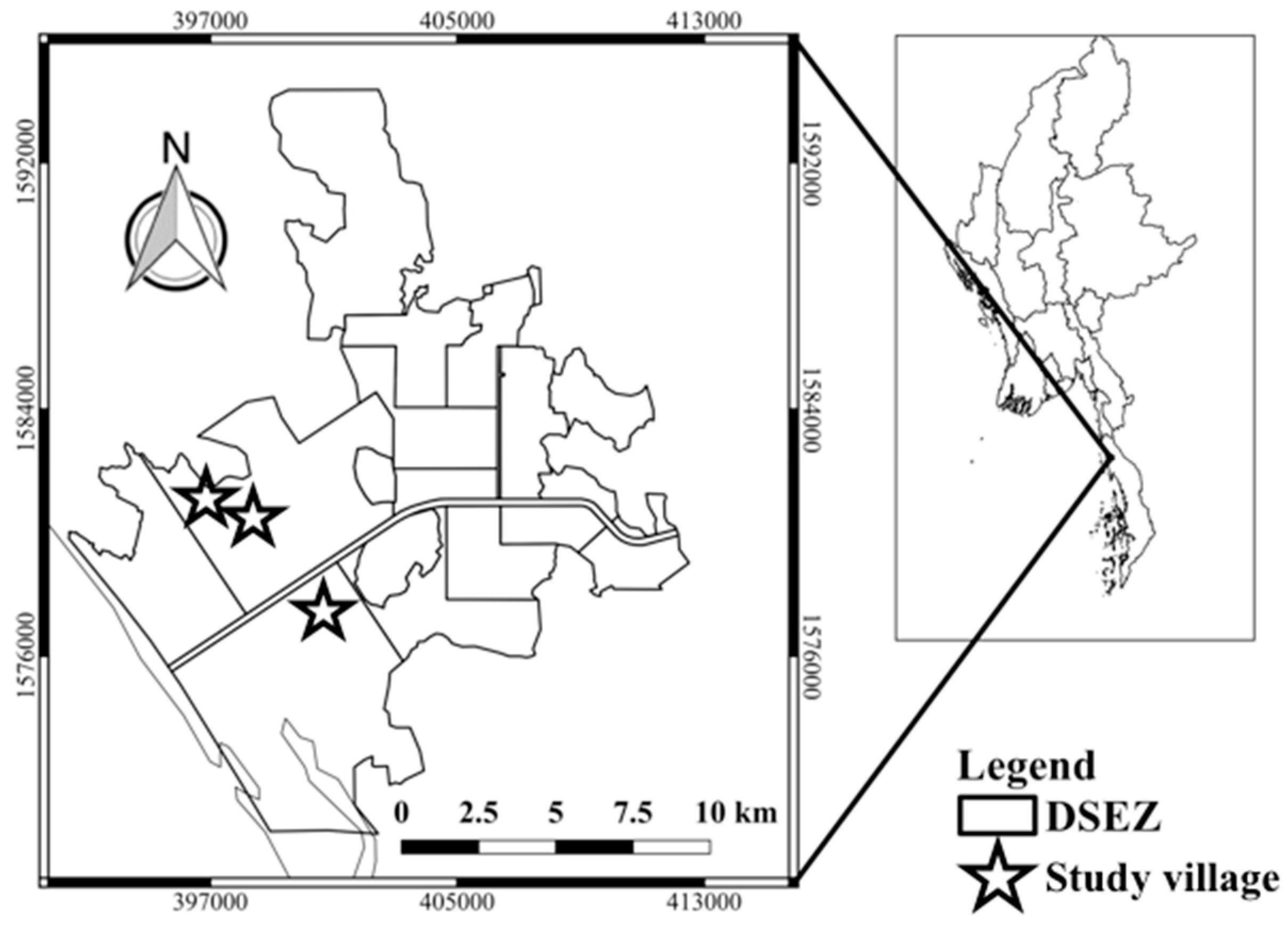

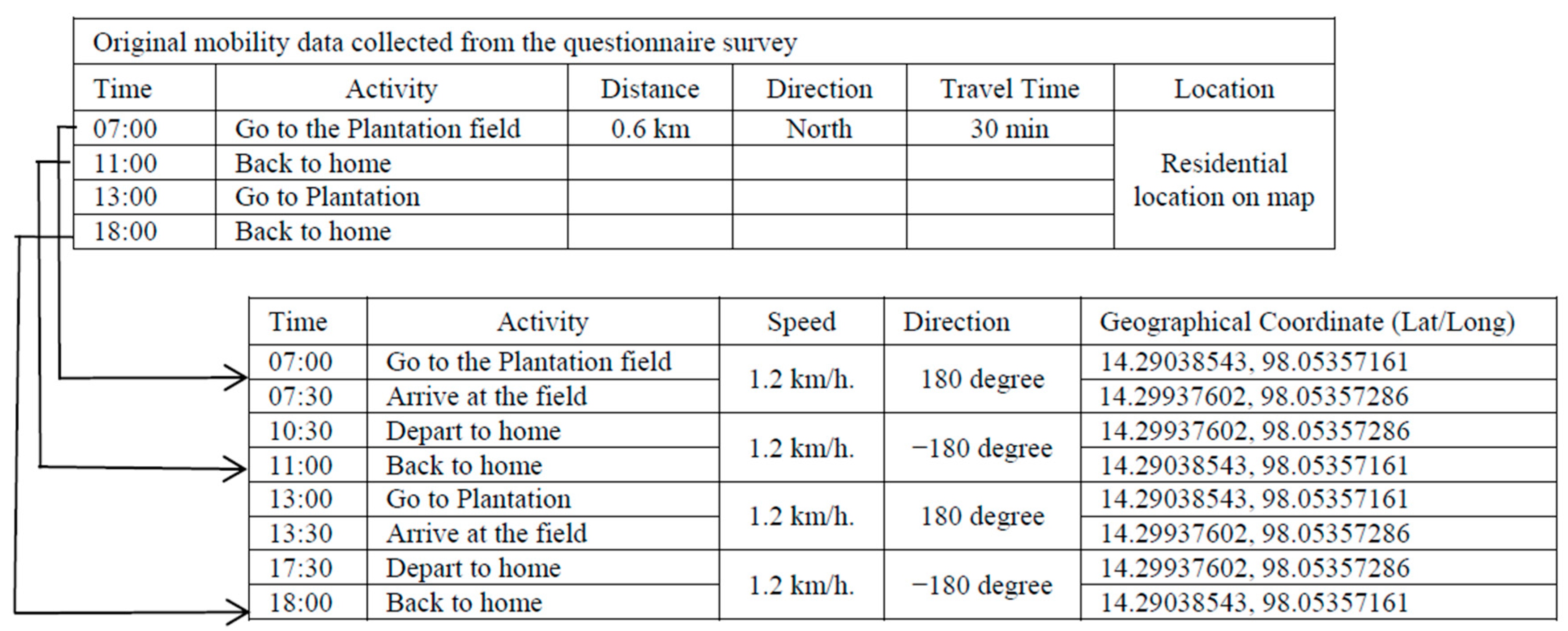

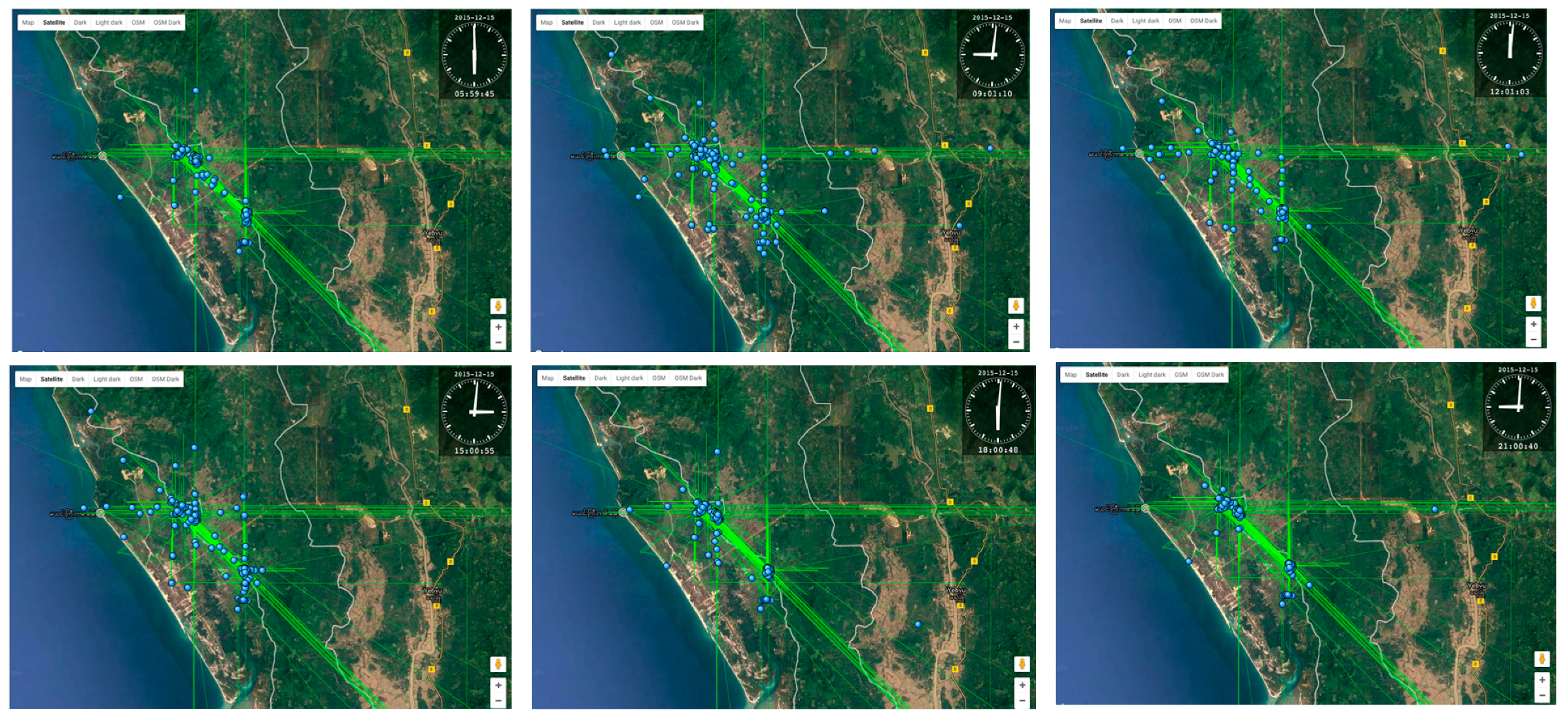
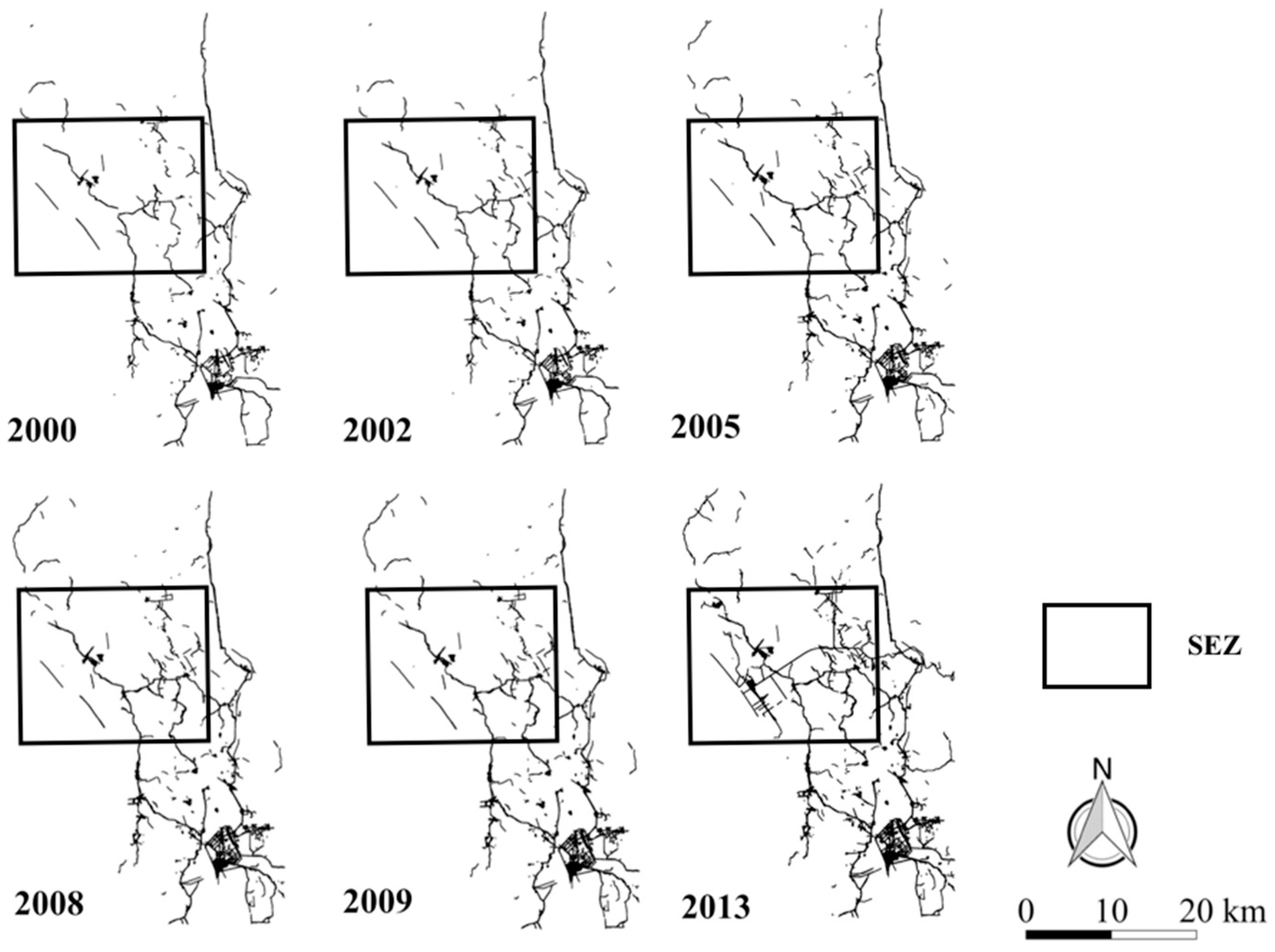
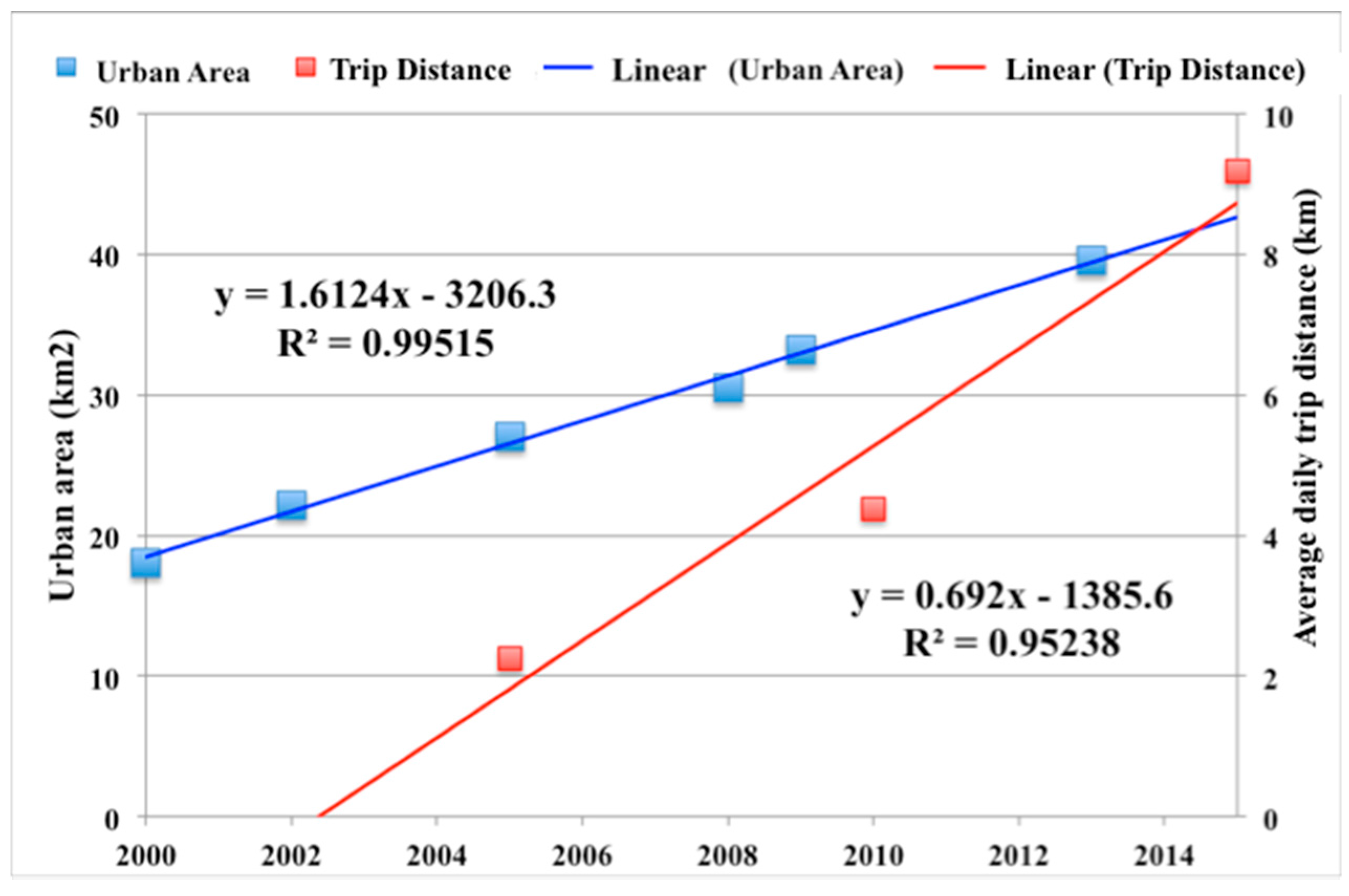
| Time | Activity | Frequency | Distance | Time |
|---|---|---|---|---|
| 07:00 | Go to the Plantation field | 1 | 0.6 km | 30 min |
| 07:30 | Arrive at the field | |||
| 10:30 | Depart to home | 1 | 0.6 km | 30 min |
| 11:00 | Back to home | |||
| 13:00 | Go to Plantation | 1 | 0.6 km | 30 min |
| 13:30 | Arrive at the field | |||
| 17:30 | Depart to home | 1 | 0.6 km | 30 min |
| 18:00 | Back to home and stay | |||
| Total | 4 | 2.4 km | 120 min |
| Mobility Patterns | Average Differences (%) |
|---|---|
| Trip frequency | 25.1 |
| Travel distance | 33.3 |
| Travel time | 36.0 |
| 2005 | 2010 | 2015 | |
|---|---|---|---|
| Trip frequency | 1.9 | 1.7 | 3.0 |
| Travel distance (km) | 2.4 | 3.6 | 9.2 |
| Travel time (min) | 33.7 | 42.4 | 45.9 |
| 2015 | 2010 | 2015 | ||
|---|---|---|---|---|
| Non-travel | Stay | 30.0 | 30.7 | 18.3 |
| Travel | Walk | 57.6 | 42.7 | 27.8 |
| Bicycle | 3.2 | 7.7 | 1.1 | |
| Motorbike | 9.2 | 17.4 | 50.6 | |
| Car | - | - | 2.0 | |
| Others | - | 1.6 | 0.3 |
| Age | 2005–2010 | 2010–2015 | ||
|---|---|---|---|---|
| Male | Female | Male | Female | |
| (A) 16–20 | 3.6 | 3.3 | 1.7 | 2.9 |
| (B) 21–30 | 1.2 | 1.5 | 1.9 | 4.9 |
| (C) 31–40 | 3.0 | 0.5 | 1.3 | 3.7 |
| (D) 41–50 | 3.3 | 1.2 | 1.2 | 2.8 |
| (E) 51–60 | 1.5 | 1.3 | 3.0 | 0.4 |
| (F) 61< | 3.0 | 1.7 | 1.4 | 1.1 |
| Average | 2.6 | 1.6 | 1.7 | 2.6 |
© 2017 by the authors. Licensee MDPI, Basel, Switzerland. This article is an open access article distributed under the terms and conditions of the Creative Commons Attribution (CC BY) license (http://creativecommons.org/licenses/by/4.0/).
Share and Cite
Kimijima, S.; Nagai, M. Human Mobility Analysis for Extracting Local Interactions under Rapid Socio-Economic Transformation in Dawei, Myanmar. Sustainability 2017, 9, 1598. https://doi.org/10.3390/su9091598
Kimijima S, Nagai M. Human Mobility Analysis for Extracting Local Interactions under Rapid Socio-Economic Transformation in Dawei, Myanmar. Sustainability. 2017; 9(9):1598. https://doi.org/10.3390/su9091598
Chicago/Turabian StyleKimijima, Satomi, and Masahiko Nagai. 2017. "Human Mobility Analysis for Extracting Local Interactions under Rapid Socio-Economic Transformation in Dawei, Myanmar" Sustainability 9, no. 9: 1598. https://doi.org/10.3390/su9091598





